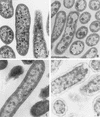The propanediol utilization (pdu) operon of Salmonella enterica serovar Typhimurium LT2 includes genes necessary for formation of polyhedral organelles involved in coenzyme B(12)-dependent 1, 2-propanediol degradation
- PMID: 10498708
- PMCID: PMC103623
- DOI: 10.1128/JB.181.19.5967-5975.1999
The propanediol utilization (pdu) operon of Salmonella enterica serovar Typhimurium LT2 includes genes necessary for formation of polyhedral organelles involved in coenzyme B(12)-dependent 1, 2-propanediol degradation
Abstract
The propanediol utilization (pdu) operon of Salmonella enterica serovar Typhimurium LT2 contains genes needed for the coenzyme B(12)-dependent catabolism of 1,2-propanediol. Here the completed DNA sequence of the pdu operon is presented. Analyses of previously unpublished pdu DNA sequence substantiated previous studies indicating that the pdu operon was acquired by horizontal gene transfer and allowed the identification of 16 hypothetical genes. This brings the total number of genes in the pdu operon to 21 and the total number of genes at the pdu locus to 23. Of these, six encode proteins of unknown function and are not closely related to sequences of known function found in GenBank. Two encode proteins involved in transport and regulation. Six probably encode enzymes needed for the pathway of 1,2-propanediol degradation. Two encode proteins related to those used for the reactivation of adenosylcobalamin (AdoCbl)-dependent diol dehydratase. Five encode proteins related to those involved in the formation of polyhedral organelles known as carboxysomes, and two encode proteins that appear distantly related to those involved in carboxysome formation. In addition, it is shown that S. enterica forms polyhedral bodies that are involved in the degradation of 1,2-propanediol. Polyhedra are formed during either aerobic or anaerobic growth on propanediol, but not during growth on other carbon sources. Genetic tests demonstrate that genes of the pdu operon are required for polyhedral body formation, and immunoelectron microscopy shows that AdoCbl-dependent diol dehydratase is associated with these polyhedra. This is the first evidence for a B(12)-dependent enzyme associated with a polyhedral body. It is proposed that the polyhedra consist of AdoCbl-dependent diol dehydratase (and perhaps other proteins) encased within a protein shell that is related to the shell of carboxysomes. The specific function of these unusual polyhedral bodies was not determined, but some possibilities are discussed.
Figures



References
Publication types
MeSH terms
Substances
Associated data
- Actions
Grants and funding
LinkOut - more resources
Full Text Sources
Other Literature Sources
Molecular Biology Databases

